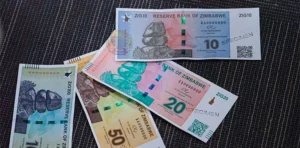On April 8, 2024, Zimbabwe transitions to the gold-backed ZiG currency, moving away from the depreciating ZWL.
This initiative, led by Central Bank Governor John Mushayavanhu, relies on 2.5 tons of gold and diverse foreign currency reserves.
The change aligns with extensive economic reforms aimed at stabilizing Zimbabwe’s economy amidst inflation and currency depreciation challenges.
The ZiG’s introduction required rapid adjustments within the financial sector, leading to a temporary halt in ZWL transactions.
Financial institutions worked diligently over the weekend to integrate ZiG into their systems.
A 21-day period allows for ZWL note deposits before complete phase-out, safeguarding the value for non-account holders.

Mushayavanhu’s reforms emphasize fiscal discipline, steering clear of the money printing that previously fueled hyperinflation.
His approach reassures markets, despite skepticism rooted in Zimbabwe’s financial history.
Zimbabwe’s Currency Reform
The central bank assures no impact on US dollar balances, with ZWL converted to ZiG at April 5 rates.
Foreign exchange policies have been standardized, with a focus on a market-driven mechanism for import finance, replacing the forex auction system.
Interest rates have been cut dramatically from 130% to 20% annually, demonstrating the central bank’s commitment to money supply control, aligned with gold and foreign currency reserves.
This strategic move towards a structured currency model, backed by gold and a currency basket, marks a significant shift in Zimbabwe‘s monetary policy.
It aims to rebuild economic stability and public confidence by addressing the deep-seated issues of currency devaluation and inflation.
The effectiveness of the ZiG and the broader reforms in revitalizing Zimbabwe’s economy will be closely watched.
Zimbabwe launches ZiG, a gold-backed currency, replacing ZWL, effective April 8, 2024, signaling a major monetary shift.
Anchored by 2.5 tons of gold and a mix of foreign currency reserves, the ZiG aims to stabilize the nation’s economy.
These include fostering exchange rate and price stability while transitioning from the severely devalued ZWL, which has plummeted against the US dollar.
Zimbabwe’s Transition to ZiG
Zimbabwe, with a multi-currency system since 2020, primarily transacts in US dollars due to its informal economy.
This stance is critical, given Zimbabwe’s history of hyperinflation linked to excessive money printing.
The central bank assures US dollar balances remain unaffected; ZWL balances will convert to ZiG at the April 5 exchange rate.
However, this move deviates from a traditional gold standard to a structured currency model, adding a contemporary twist to currency backing.
This bold step by Zimbabwe aims to restore economic stability and confidence, addressing long-standing issues of inflation and currency devaluation.

